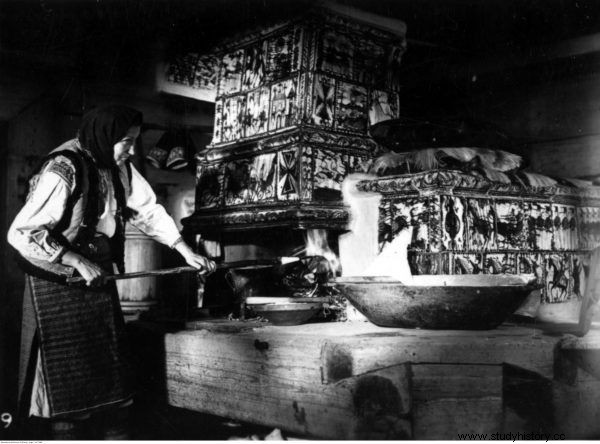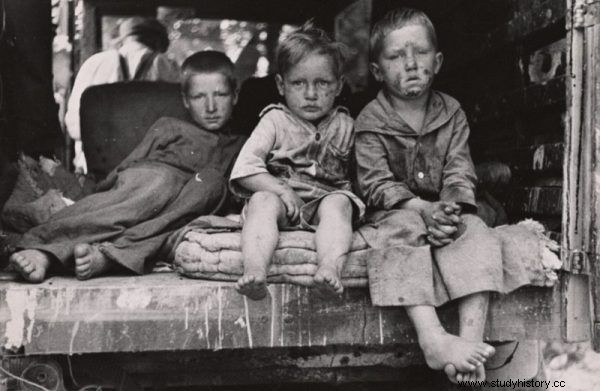They had to fight poverty and frauds. They were constantly being told to prove that they were not inherently stupider than men. And they were always fired in the first place. What else did women in pre-war Poland endure?
As always, all positions in the TOP10 ranking are based on the articles we publish. This time we decided to show the women's history of pre-war Poland, with all its load of toil and toil. You can find more about the interwar years HERE.
It should be remembered that our great-grandmothers struggled with…
10. Perfidious food scams

Stalls at Sapieżyński Square in Poznań. One of those places where the Polish housewife could be brazenly deceived.
Even usually, shopping in the market square was a painful journey for a pre-war housewife. Sellers cheated on milk, for example. It was often stale, diluted with water and colored with carrot juice. Dishonest merchants also tinkered with butter, although it was much more difficult. First of all, they tricked customers on the weight of the product. They added substances to the butter to increase its weight and volume:water, buttermilk, salt, flour, potato paste, and even talc and plaster (read more about this).
9. Market unpredictability

A woman from the Sarna County next to her dilapidated house. Although we do not want to remember this today, huge numbers of the population lived in extreme poverty.
Sometimes even the hardest work did not allow for the existence of the loved ones. As reported by the Braslaw settler Zofia Pujszowa, fattening and selling hogs became a source of trouble for her. She spent a total of PLN 106 for fodder, the purchase of a piglet and the possibility of putting it on the market. For an adult hog, she got a ridiculous 35 zlotys. Too much to immediately get ready to starve to death, not enough to live normally ... and think about another investment of this type (read more on this topic).
8. No refrigerators

The “Ideał” factory ice shop exhibition.
In the Second Republic of Poland, the refrigerator was equipment for the elite and cost as much as a new car . A typical Polish woman must have known how to do without her. Ladies could use specially dug buildings in the ground - ice houses - or buy ice subscriptions from private entrepreneurs. Both of these options were also expensive, moreover, in order to buy ice at all, you had to first have a room ice house. The average woman was left with drying, pickling and other traditional preservation methods (read more on this).
7. Accusations that they are too stupid to use electricity ...

Woman + electric iron =misfortune? The pre-war Polish press could easily subscribe to such an equation. Photo from 1936.
According to pre-war reporters, electricity gave straw widowers the opportunity to easily prepare a meal for themselves. Ladies, as beings less reasonable and not understanding the seriousness of the situation, were particularly exposed to the dangers of this new invention. After all, only a woman could grab an iron with a wet hand or carelessly grab a metal stand for a bedside lamp ... (read more on this topic).
6. … Or no electricity at all

Traditional tiled stoves took up space, smelt and smeared. Not like electric cookers, which for many were an inaccessible luxury…
Electricity appeared on the Vistula River even before the First World War. In the houses of workers and in the countryside, electricity was still a luxury in the twenty years. Even in wealthy villages, there was often no money not only for electricity, but also for kerosene or matches. For a part of society, the double-plate cooker had to remain a dream come true. After all, even after electrification, you would still have to pay PLN 110 for it, and in the option with an oven - as much as PLN 550. Despite the installment sale, it was not an option for every budget (read more on this topic).
5. No dishes that are obvious to us

Such gluttony was a dream for most Poles. Actor Józef Leliwa in an exaggerated portrait showing him eating a meal.
Dishes that we consider to be Old Polish, such as pork chop, tartare, pork knuckle or bigos, were hardly ever served on typical pre-war tables. The basis for the preparation of meals for the rural hostess were potatoes, groats, own flour, cabbage, broad beans and everything that could be sown and grown by yourself. In addition, mushrooms, forest fruits and fish were eaten. Poultry and pork appeared on the tables infrequently. In addition, making a few filling dishes out of a small piece of meat was a real challenge (read more about it).
4. Maintaining hygiene during menstruation

Menstruation or not, you need to wash yourself. And what to use for this purpose if not soap?
Pre-war women sewed underwear with their own hands, including the one for menstruation. It was much more complicated than the usual one. During menstruation, women had to tie several straps that were supposed to hold a special insert. The insert itself also came out from under the needle of the lady of the house. It could be up to half a meter long! You fastened it to the straps, wore as much as you needed and then boiled it (read more on this).
3. A group of children who needed to be provided for.

In poor families, each new child could already mean the difference between deep poverty and starving to death.
Families of pre-war factory workers lived in cramped, dirty rooms. One more child could mean the difference between deep poverty and starving to death. The father, hearing about the birth of another daughter, could hiss:"There will be one more whore." Also for women, the news that she was expecting a baby was not always joyful. Each subsequent birth could mean death from exhaustion and disease. And whether the offspring would survive was questionable. No one was surprised if out of ten children only two or three, dwarfed and emaciated, lived to adulthood (read more on this topic).
2. A deadly contraception

During the Great Depression, Lysol was the most popular and most widely promoted anti-stress preparation in the USA. It was from there that it came to the Vistula.
If a woman wanted to avoid the fate of a mother burdened with a group of children, she also risked her life. In the times of our great-grandmothers, spermicidal substances were used, which make the hair stand on the head. These include mercury preparations such as disinfectant and highly poisonous sublimate, as well as salicylic acid, formic acid and lysol. The latter is a former toilet cleaner with an intense, nauseous odor that, if concentrated too much, can lead to burns and even death (read more on this topic).
1. Priority ... for dismissals (and omitting promotions)

Telephone exchange in Warsaw.
During the war years, when men fought on the fronts, women practiced various jobs. When the veterans returned after 1918, it turned out that there were too many workers in many places. A secret instruction spread across the country covering two important points. First, if any staff reduction was planned at a government office, would be women first. Second, even the best-qualified civil servants could only be promoted to a specific position (read more on this).
